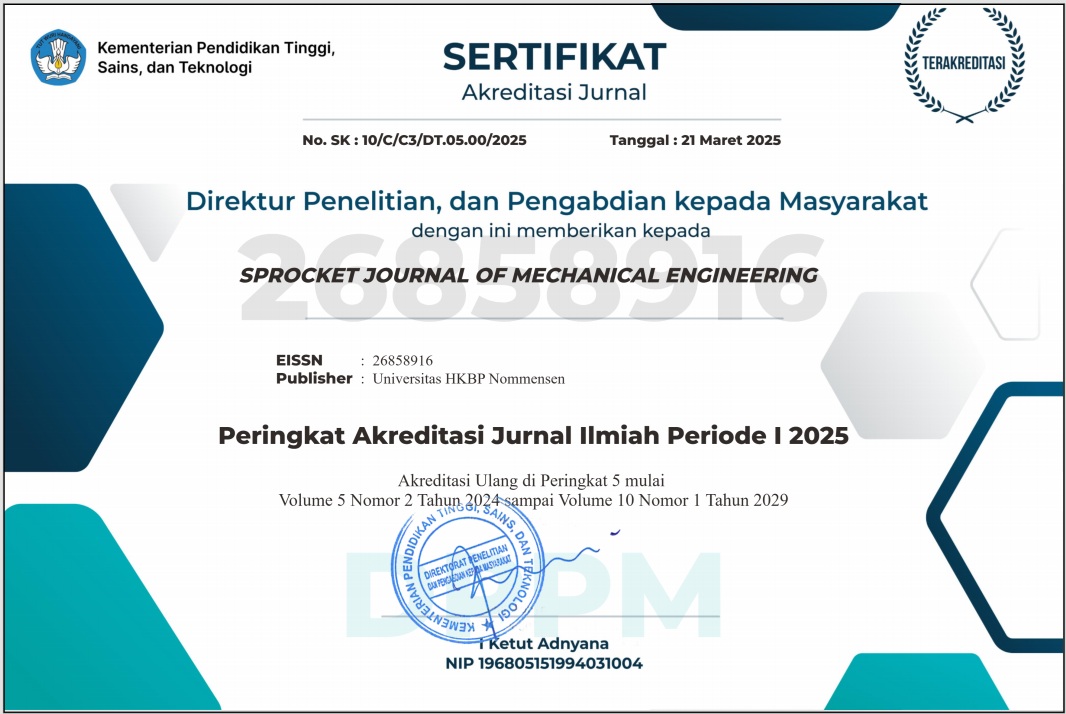Pengaruh Material Reflektor Terhadap Kinerja Kompor Energi Surya
Abstract
The use of solar energy in Indonesia is the right choice as an alternative energy for energy needs in industry or to meet daily energy needs in households. To utilize solar energy for cooking purposes, a solar cooker can be used. Factors that affect the performance of this solar cooker in addition to the length of time it shines and the intensity of thermal radiation from the sun are the reflexivity of the collector material, the surface area of the collector, the geometric shape and location of the focal point of the collector, the normal direction of the collector surface to the incoming sunlight, and the amount of heat loss to the surroundings. The materials used as reflectors in the research on this solar cooker are zinc (aluminum and galvanized) AL-Zn and black paint back ground mirror glass. This material is re-glued on top of a ready-made parabolic dish from the market. Then look for the focal point that corresponds to the diameter of the parabola. From the results of the study, it can be concluded that the back ground mirror glass material with black paint is better to use than the AL-Zn zinc plate if it is used as a raw material for the surface material (reflector) of solar cooker. Likewise, the efficiency of the solar oven in terms of the amount of heat that is converted into energy for heating the pot is better for a solar oven than a reflector with black paint back ground mirror glass material. And the efficiency of the solar cooker from the black paint back ground mirror on the first day is 16.4% to 25.7% on the second day, while the efficiency of the solar cooker from the AL-Zn zinc plate on the first day is 16.4% to second day 22.8%. The emissivity of the solar stove with AL-Zn zinc plate reflector on the first day was 0.02906 and on the second day 0.02892, while the emissivity of the solar cooker with black paint back ground mirror reflector on the first day was 0.01812 and the second day was 0 0.02544.
References
2. Kalogirou, Soteris. 2009 Handbook Solar Energy Engineering – Processes and Systems first edition. Includes bibliographical references and index.
3. Azmain Noor Hatuwe, Alexander Andaria Patty, (2010), Studi eksperimen kinerja kompor surya tipe kotak dengan kombinasi reflector datar dan parabola, Jurnal TEKNOLOGI, Volume 5 Nomor 2.
4. Masyhudi, Basori, Asmaw, 2013, Rancang Bangun Kompor Tenaga Surya Berdiameter 191 Cm, Jurnal Ilmiah GIGA Volume 16 (1)
5. Mohammad Bayu Dwicaksono, Chalilullah Rangkuti, 2017, Perancangan, Pembuatan, dan Pengujian Kompor Energi Matahari Portabel Tipe Parabola Kipas, Prosiding Seminar Nasional Cendekiawan ke 3
6. Adinda Ayuning Amri, Mokhammad Nuruddin, Risse Entikaria Rachmanita, 2020, Uji Performa Kompor Surya Tipe Parabola Silinder Menggunakan Reflektor Cermin dengan Variasi Bahan Absorber, Jurnal Energi dan Manufaktur Vol. 13 No. 1.
7. Hatuwe, Azmain Noor , 2011, Kajian Pengaruh Penggunaan Reflektor Parabola Terhadap Cooking Power Kompor Surya Tipe Kotak, Jurnal Teknik Mesin Transmisi Vol. 7 No. 1
8. Abdul Haris Subarjo, Benedictus Mardwianta, Anugrah Budi Wicaksono, 2019, Efisiensi Kompor Surya Parabola Berreflektor Cermin Untuk Menunjang Ketahanan Energi, JURNAL SURYA ENERGY Vol. 4 No. 1
9. Fitri Wijayanti, H.Ahsan, 2012, Uji Kinerja Kompor Surya Dengan Variasi Bentuk Geometri dan Luas Kolektor, Prosiding Seminar Nasional Teknik Mesin 7, Surabaya
10. Abdul Muin, 2017, Peningkatan kinerja kompor surya tipe kotak dengan penambahan cermin reflektor, Jurnal Austenit Vol. 9 No. 2
11. Risse Entikaria Rachmanita, Ganisa Dwi Suryanto, Meilana Siswanto, 2020, Pengaruh Sudut Kemiringan Ruang Masak dan Penggunaan Lensa Fresnel terhadap Performa Kompor Surya Tipe Kotak, Jurnal Teknologi Terpadu Vol. 8 No. 1
12. Abdul Muin, 2017, Kajian Kinerja Kompor Surya Dengan Variasi Susunan Absober, Machine: Jurnal Teknik Mesin Vol. 3 No. 1

This work is licensed under a Creative Commons Attribution 4.0 International License.
Penulis yang menerbitkan dengan SPROCKET JOURNAL OF MECHANICAL ENGINEERING menyetujui ketentuan berikut :
- Penulis memegang hak cipta dan memberikan jurnal hak penerbitan pertama dengan karya yang dilisensikan secara bersamaan di bawah Lisensi Internasional Creative Commons Atribusi 4.0 . yang memungkinkan orang lain untuk berbagi karya tersebut dengan pengakuan atas kepengarangan karya dan penerbitan awal dalam jurnal ini.
- Penulis dapat membuat pengaturan kontraktual tambahan yang terpisah untuk distribusi non-eksklusif atas versi jurnal yang diterbitkan dari suatu karya (misalnya, mempostingnya ke repositori institusional atau menerbitkannya dalam sebuah buku), dengan pengakuan atas penerbitan awalnya di jurnal ini.
- Penulis diizinkan dan didorong untuk mengunggah karya mereka secara daring (misalnya, di repositori institusi atau di situs web mereka) sebelum dan selama proses penyerahan, karena hal ini dapat mengarah pada pertukaran yang produktif, serta kutipan yang lebih awal dan lebih banyak dari karya yang diterbitkan (Lihat Pengaruh Akses Terbuka ).






.png)
.png)

